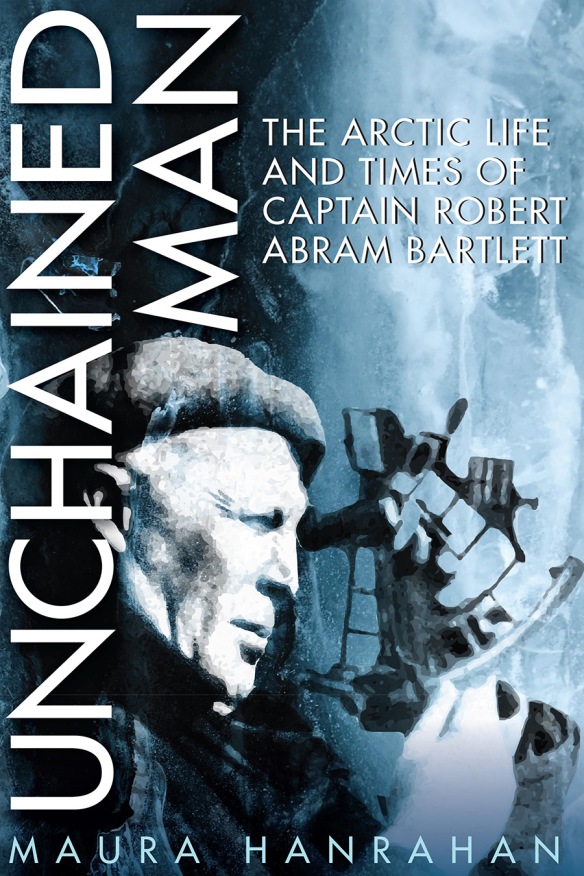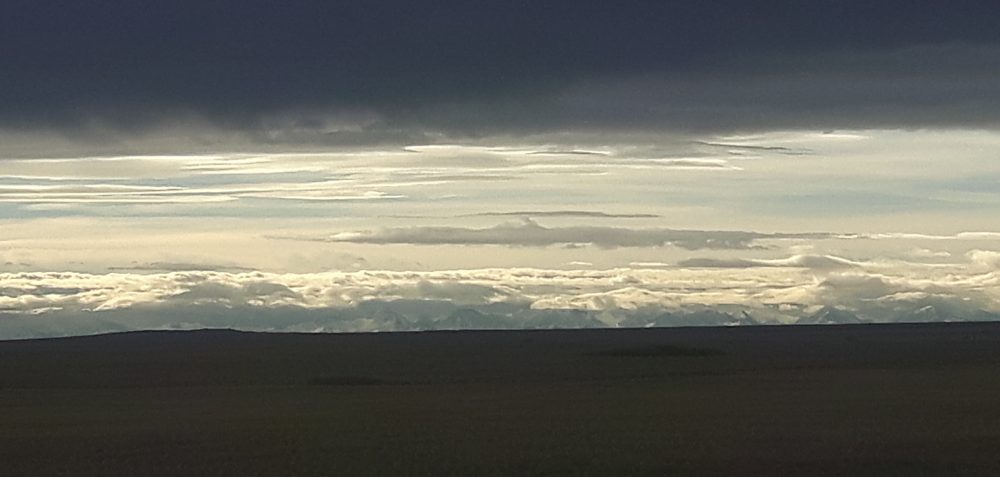A lifetime of interest and 13 research years research has yielded Maura Hanrahan‘s biography of Captain Bob Bartlett, Unchained Man: The Arctic Life and Times of Captain Robert Abram Bartlett. Maura researched at the archives of Bowdoin College, Maine; Dartmouth College, New Hampshire; Scott Polar Research Institute, Cambridge; The National Maritime Museum in Greenwich, London; The University of Greenland, Nuuk; Library and Archives Canada, Ottawa; as well as The Rooms Provincial Archives, Newfoundland and Labrador. In Unchained Man, the depth of research shows.
Here is my Q & A with Maura:
Q. 1. In your newly-released book Unchained Man: The Life and Times of Captain Robert Abram Bartlett (Boulder Publications), the reader has the delight of experiencing some of Bartlett’s most famous escapades in greater detail and with a special focus on the social and cultural context of exploration in Bartlett’s era. The book draws attention to the way that the contributions of Indigenous people are minimized, for instance. For me it was like hearing about Bartlett’s adventures for the first time. Far from weighing down the writing, the sense of context actually brought everything, including Bartlett’s extraordinary physical achievements, vividly to life. Did it come naturally to you? Or did you have to work at keeping it pacey and fresh even while the book sheds light on matters of background and social history?

MH: My goal was to tell Bartlett’s story but not in a Boy’s Own hero kind of way, the way it’s often been told. Without fleshing him out, Bartlett remains a symbol. You can read anything into a symbol but you are missing out an unparalleled true story. Bartlett wasn’t in the Arctic on his own—he was part of ships’ crews, scientific teams, and he was the boss of — as well as friend to — Inuit ‘assistants.’ At home in Brigus, he was an involved family member and the heir to a remarkable seagoing tradition with all the pressure this involved. In New York, where he spent most of his adult life, Bartlett was part of Manhattan high society. Internationally, he was among the elite world of explorers, his every move and plan followed by, for instance, the Times of London. I was interested in how he navigated all those roles and how he lived them. Was it an integrated or as a fractured person? Or as something in between?
I’ve spent time in the Arctic and subarctic as an academic and as a land claims researcher so the geophysical context was always revealing itself to me. Like Bartlett, I fell in love with the northern landscape and the deep feelings of peace it engenders. I worked with Inuit so I came to understand and respect their role in exploration; it’s something many Inuit say they deserve more credit for (even though exploration also caused harm to Inuit society). Though Inuit are still backgrounded, as the book is a biography of Bartlett, I think it’s a step in support of Inuit.
So you have this incredible stories which almost tell themselves, they are so riveting. I did research in four countries to get as much detail as I could. By adding context, different events make more sense or take on more meaning. I had a great deal of fun writing this, picturing Bartlett on Wrangel Island or a dinner at the Explorers Club and so on.
Q. 2. One of the themes which emerges quite early and remains throughout this book is Bartlett’s loneliness. His sense of isolation is really quite vivid, particularly in New York, as were his periods of hunger. Was this something that emerged slowly from the research and did it surprise you?
MH: Bartlett’s loneliness emerged slowly. I knew he wasn’t married when I started the research but that doesn’t mean he wasn’t contented or someone who didn’t fit in. As I delved into archival research, I began to recognize his loneliness, not just as an acquired trait, but something that was inherent in his personality, something he had to tend to and follow. Emily White’s book, Lonely, explains this phenomenon very well. What surprised me was the complexity of his personality, including the depth of this aspect.
Q. 3. One of the aspects explored in this book is that Bartlett’s public persona – the one we see in his own ghostwritten books – was at times quite sharply at odds with the man. He was in some ways well ahead of his time in the sense of having a “media” image – bluff, no nonsense, jovial — he wore like a mask. Just how self-aware do you think he was about this?
MH: Bartlett was intelligent and usually knew what he was doing. The lecture circuit was big in the 1920s and 1930s with many speakers’ bureaus in New York. The PR machine was in full swing and Bartlett knew how the play the game. Some of the letters between him and his agents demonstrate this and I’ve quoted them in the book. He wasn’t entirely cynical about this; he needed money to fund his trips to the Arctic, where he wanted to be.
Q. 4. There are some haunting passages about Bartlett’s private yearnings. Without giving too much away, did some of the letters in your research make you stop cold? Did you ever think you had suddenly found the “real Bob Bartlett”?
MH: I think I got to the core of his longing and sadness and how and where he found some relief, besides being in the Arctic which was always a balm for him. Jennifer Niven, who wrote the best-selling book, The Ice Master, refers to him as “enigmatic” in her endorsement of Unchained Man. He was indeed. Enigmatic people always have a fascinating story so I hope I’ve got to the kernel of Bartlett’s. It’s certainly time for us to get to know and understand him as a real person, not a cardboard cut-out hero. I have loved spending all these years with him.
Praise for Unchained Man
Wayne Johnston, The Navigator of New York:
Maura Hanrahan has written a fine book about one of Newfoundland’s most famous seamen and arctic explorers, Bob Bartlett. In Unchained Man—meticulously researched and finely written—she has come closer than any writer yet to solving the enigma of the great Bob Bartlett. From the haunting sinking of the Karluk to the epic struggle to reach the North Pole with Admiral Peary, Hanrahan depicts Bartlett as a flawed but extraordinary human being. This book is unforgettable, a must read for lovers of the literature of exploration and the still uncharted region of the Arctic.
Jennifer Niven, the New York Times best-selling author of The Ice Master:
A riveting comprehensive portrait of one of the most dynamic and enigmatic sea captains the Arctic has ever seen. Robert Abram Bartlett was larger than life, his adventures the stuff of legends. Maura Hanrahan expertly recounts the long overdue, very true story of this understated polar hero in engaging, dramatic prose.
